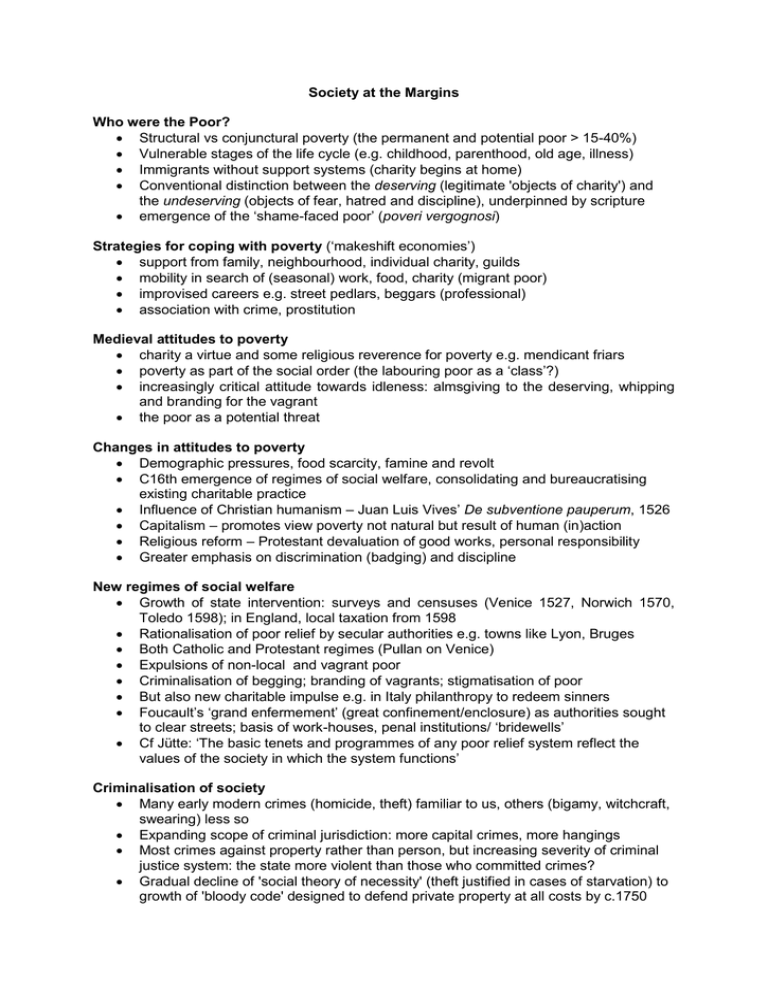
Society at the Margins
Who were the Poor?
Structural vs conjunctural poverty (the permanent and potential poor > 15-40%)
Vulnerable stages of the life cycle (e.g. childhood, parenthood, old age, illness)
Immigrants without support systems (charity begins at home)
Conventional distinction between the deserving (legitimate 'objects of charity') and
the undeserving (objects of fear, hatred and discipline), underpinned by scripture
emergence of the ‘shame-faced poor’ (poveri vergognosi)
Strategies for coping with poverty (‘makeshift economies’)
support from family, neighbourhood, individual charity, guilds
mobility in search of (seasonal) work, food, charity (migrant poor)
improvised careers e.g. street pedlars, beggars (professional)
association with crime, prostitution
Medieval attitudes to poverty
charity a virtue and some religious reverence for poverty e.g. mendicant friars
poverty as part of the social order (the labouring poor as a ‘class’?)
increasingly critical attitude towards idleness: almsgiving to the deserving, whipping
and branding for the vagrant
the poor as a potential threat
Changes in attitudes to poverty
Demographic pressures, food scarcity, famine and revolt
C16th emergence of regimes of social welfare, consolidating and bureaucratising
existing charitable practice
Influence of Christian humanism – Juan Luis Vives’ De subventione pauperum, 1526
Capitalism – promotes view poverty not natural but result of human (in)action
Religious reform – Protestant devaluation of good works, personal responsibility
Greater emphasis on discrimination (badging) and discipline
New regimes of social welfare
Growth of state intervention: surveys and censuses (Venice 1527, Norwich 1570,
Toledo 1598); in England, local taxation from 1598
Rationalisation of poor relief by secular authorities e.g. towns like Lyon, Bruges
Both Catholic and Protestant regimes (Pullan on Venice)
Expulsions of non-local and vagrant poor
Criminalisation of begging; branding of vagrants; stigmatisation of poor
But also new charitable impulse e.g. in Italy philanthropy to redeem sinners
Foucault’s ‘grand enfermement’ (great confinement/enclosure) as authorities sought
to clear streets; basis of work-houses, penal institutions/ ‘bridewells’
Cf Jütte: ‘The basic tenets and programmes of any poor relief system reflect the
values of the society in which the system functions’
Criminalisation of society
Many early modern crimes (homicide, theft) familiar to us, others (bigamy, witchcraft,
swearing) less so
Expanding scope of criminal jurisdiction: more capital crimes, more hangings
Most crimes against property rather than person, but increasing severity of criminal
justice system: the state more violent than those who committed crimes?
Gradual decline of 'social theory of necessity' (theft justified in cases of starvation) to
growth of 'bloody code' designed to defend private property at all costs by c.1750
Criminalisation of certain groups for unstable, immoral lifestyle, e.g. prostitutes,
gypsies
Vagrants in foreign pay blamed for malicious acts of arson (along with witches,
Dillinger cf ‘terrorists’ of early modern age)
Gypsies/Roma
Relatively novel presence in western Europe (from C15th)
Suspected involvement in property crime (horse-stealing, pick-pocketing)
Itinerant lifestyle, exotic appearance and activities (fortune-telling, gambling etc)
made suspect
Easy target for expulsion; transportation to colonies C18th [cf Slaves – dynamic
Mediterranean trade, Muslims & Christians, overtaken by transAtlantic by C18th]
Prostitutes
Broadly tolerated in Middle Ages, taxed, legalised brothels
Impact of Protestant and Catholic Reformations made less acceptable, driven
underground. Other women police activities, e.g. Marseille.
‘A Harlot’s Progress’ (Hogarth 1730s) charted dangers, relatively sympathetic
portrait?
Sexual deviants
Chiefly sodomy (wide-ranging term for ‘unnatural’ practices), phase rather than
lifestyle, practice notorious in northern Italian cities of Venice and Florence
In theory, harshest of penalties applied, in practice often lesser charge
‘Molly houses’ of C18th London (mission of Society for Reformation of Manners to
close down brothels)
Sexual relationships between women lesser concern unless challenged patriarchy
Dishonourable Trades
Less scandalous role of ‘dishonourable trades’, e.g. executioner, skinner, latrinecleaner, grave-digger (Stuart on Germany)
Socially ostracised, but essential socio-economic role > far from marginal
Own subculture: intermarried, passed occupations on, lived in restricted areas
Essentially status more symbolic than actual
Historians ‘centring the margins’ > greater degree of agency
Issues for Discussion
How 'marginal' were marginal groups? (briefly)
What impact did the Renaissance, the Reformations and the Enlightenment have on
the treatment of and attitudes towards marginal groups?







